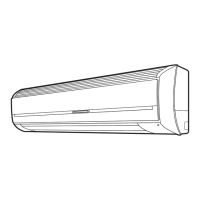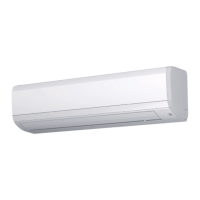the outdoor unit during shipping and installation. The
reusable service valves are provided to evacuate and
charge per this instruction.
Serious service problems can be avoided by taking
adequate precautions to assure an internally clean and
dry system.
CAUTION
Dry nitrogen must always be supplied through
the tubing while it is being brazed, because the
temperature required is high enough to cause
oxidation of the copper unless an inert atmosphere is
provided. The flow of dry nitrogen must continue until
the joint has cooled. Always use a pressure regulator
and safety valve to insure that only low pressure
dry nitrogen is introduced into the tubing. Only a
small flow is necessary to displace air and prevent
oxidation.
Precautions during brazing of service
valve
WARNING
This is not a backseating valve. The service access
port has a valve core. Opening or closing valve does
not close service access port. If the valve stem is
backed out past the chamfered retaining wall, the
O-ring can be damaged causing leakage or system
pressure could force the valve stem out of the valve
body possibly causing personal injury.
Precautions must be taken to prevent heat damage to
service valve by wrapping a wet rag around it as shown in
Figure 7. Protect all painted surfaces, insulation, and the
plastic base during brazing. After brazing, cool the joint
with a wet rag.
Open the valve by removing the service valve cap, fully
inserting a hex wrench into the stem, and backing out
counterclockwise until the valve stem just touches the
chamfered retaining wall.
Connecting the refrigerant lines
Connect the refrigerant lines using the following
procedure:
1. Remove the cap and Schrader core from both the
liquid and vapor service valve service ports at the
outdoor unit. Connect low pressure nitrogen to the
liquid line service port.
2. Braze the liquid line to the liquid valve at the
outdoor unit. Be sure to wrap the valve body with a
wet rag. Allow the nitrogen to continue flowing.
3. Carefully remove the plugs from the indoor coil
liquid and vapor connections at the indoor coil.
Figure 7: Heat protection
CAUTION
Do not install any coil in a furnace which is to
be operated during the heating season without
attaching the refrigerant lines to the coil. The
coil is under pressure which must be released
to prevent excessive pressure build-up and
possible coil damage.
4. Braze the liquid line to the indoor coil liquid
connection. Nitrogen must be flowing through the
indoor coil.
5. Slide the grommet away from the vapor connection
at the indoor coil. Braze the vapor line to the
indoor coil vapor connection. After the connection
has cooled, slide the grommet back into original
position.
6. Protect the vapor valve with a wet rag and braze
the vapor line connection to the outdoor unit. The
nitrogen flow must be exiting the system from the
vapor service port connection. After this connection
cools, remove the nitrogen source from the liquid
fitting service port.
7. Replace the Schrader core in the liquid and vapor
valves.
8. Go to the section for TXV installation.
Installation Manual: R-410A Outdoor Split-System Air Conditioner10
Johnson Controls Ducted Systems

